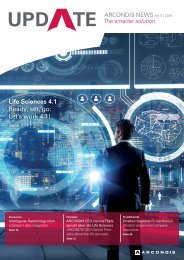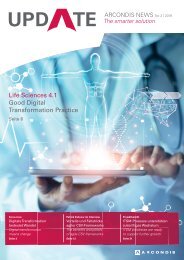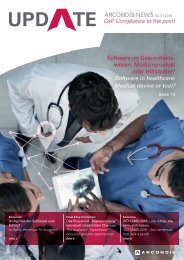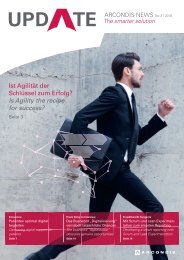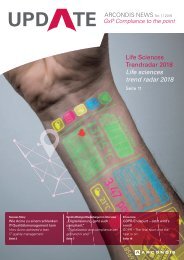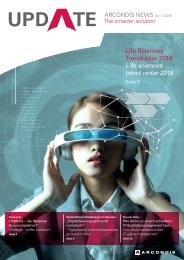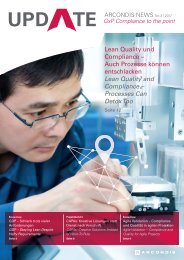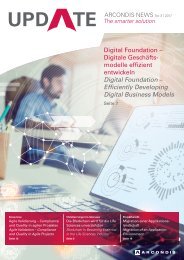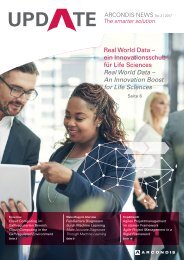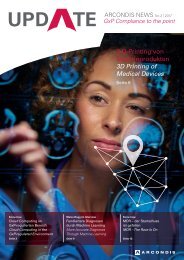ARCONDIS UPDATE No. 02|2018: The smarter solution
ARCONDIS Kundennewsletter für den Themenbereich Business Applications in Life Sciences Unternehmen
ARCONDIS Kundennewsletter für den Themenbereich Business Applications in Life Sciences Unternehmen
Erfolgreiche ePaper selbst erstellen
Machen Sie aus Ihren PDF Publikationen ein blätterbares Flipbook mit unserer einzigartigen Google optimierten e-Paper Software.
20_<strong>The</strong> <strong>smarter</strong> <strong>solution</strong><br />
21<br />
Selecting a company-specific approach primarily<br />
depends on whether the SAP migration<br />
is considered an IT project and handled<br />
accordingly, or whether the company would<br />
like to use the opportunity to optimize or<br />
even completely redesign business processes.<br />
One thing is certain: from a technological<br />
standpoint, SAP ECC 6.0 and SAP S/4 HANA<br />
are majorly different. This means, no matter<br />
whether migration is pursued as an IT<br />
project or with a more of a business-driven<br />
approach, basic technical questions such as<br />
the following have to be considered:<br />
Transformation of the SAP system<br />
landscape with data migration, implementation<br />
of unicodes, introduction of the<br />
new general ledger, migration to HANA<br />
databases, etc.<br />
Customer-specific SAP developments and<br />
technical objects: Analysis of migratability<br />
and required adaptations<br />
User interfaces: Use and impact of FIORI<br />
apps, including partial or complete replacement<br />
of the SAP GUI<br />
Reporting & analytics: Analysis and adaptation,<br />
including supply of any available<br />
data warehouse <strong>solution</strong>s<br />
Verification of permissions and required<br />
adaptations<br />
Test, documentation and go-lives<br />
Integration technologies and interface<br />
topics<br />
Add to this industry-specific topics resulting<br />
due to migration of data models, the introduction<br />
of the FIORI apps, etc.<br />
In most cases, existing ERP platforms have<br />
been in use for several decades and are<br />
tailored very specifically to the customer’s<br />
requirements. <strong>The</strong> result is a great deal<br />
of “relics” in the form of customizations,<br />
programming and a stock of legacy data.<br />
Besides lacking or obsolete and incomplete<br />
documentation, this also complicates maintenance<br />
and makes a technical migration<br />
difficult to plan and calculate. Extensive analysis,<br />
as well as comprehensive and repeated<br />
testing are therefore absolutely necessary.<br />
Brownfield vs. Greenfield<br />
Practical experience shows that some<br />
customers initially lean towards the Brownfield<br />
approach, but opt for Greenfield after<br />
initial analyses for the reasons named above,<br />
even if the project has an IT focus. Overall,<br />
a Brownfield migration means significant<br />
internal and external investments and high<br />
resource usage. In comparison, the benefits<br />
for business and IT are few, primarily the<br />
actual cause for migration: maintenance by<br />
SAP is guaranteed.<br />
Customers taking a business-driven approach<br />
for their SAP migration normally<br />
begin with the Greenfield approach right<br />
from the start. <strong>The</strong>se companies specifically<br />
opt for a “fresh start” and the opportunity<br />
for major changes and transformation. Here,<br />
the focus is on optimizing business process,<br />
often based on best practice approaches,<br />
and maybe even realigning the organization<br />
and reevaluating added value in the business<br />
departments and IT. Establishing a basis for<br />
future digitalization while optimizing processes<br />
for master data is often also an important<br />
driver. Though the impulse for change initially<br />
comes from IT, many companies choose this<br />
long-term, organization-wide approach to<br />
achieve major advantages on the business<br />
and IT side.<br />
Depending on the size, scope and approach,<br />
we recommend realizing an organization-wide<br />
transformation project. An<br />
integral component for long-term, successful<br />
transformation should be professional organizational<br />
change management so a planned<br />
migration reaches the target state involving<br />
stakeholders.<br />
Success factors in planning<br />
<strong>The</strong>se considerations make clear that the<br />
“how” also has a major impact on the<br />
“when.” Migration absolutely requires foresighted<br />
budget and resource planning, as<br />
in professional program and change management.<br />
Even purely technical migrations<br />
require a timeframe of several months, if not<br />
years for all required steps including the right<br />
resources (e.g.: external SAP specialists, key<br />
users for tests, etc.).<br />
<strong>The</strong> transformation approach also requires<br />
preparations at the top management level,<br />
as priority, commitment and sufficient resources<br />
are essential to project success, and<br />
have to be ensured by the top level.<br />
Other critical success factors include:<br />
Extensive involvement of the business<br />
departments<br />
Selecting the right external partners for<br />
support in transformation and system<br />
validation<br />
Definition of a tailored validation strategy<br />
In-depth clarification of technological dependencies<br />
(with a transformation, the IT<br />
landscape will change more dramatically<br />
than with a pure migration)<br />
Ensuring internal resources<br />
Brownfield<br />
Approach<br />
Select the best available SAP system for the current<br />
SAP landscape<br />
Adapt to new processes and prepare as a template<br />
Migrate technical data from the selected Brownfield<br />
SAP<br />
Migrate technical data from remaining SAP systems/<br />
companies to the new template<br />
Pros<br />
Knowledge of SAP functions already exists<br />
Reduced complexity in IT SAP landscape<br />
Technical data migration instead of full system migration<br />
Lower project risk thanks to existing interfaces and<br />
integration<br />
Cons<br />
Technical upgrade to S/4 HANA required<br />
Conserve current processes and IT SAP <strong>solution</strong><br />
(Brownfield)<br />
Effort for existing customer-specific extensions<br />
Less process optimization than use of existing processes<br />
One winner, many losers<br />
Professional organizational change<br />
management tailored to the culture and<br />
degree of maturity of the organization.<br />
To avoid being hard-pressed for time, you<br />
should begin planning and preparing your<br />
“SAP transformation” or “SAP strategy” in<br />
good time.<br />
This includes ensuring the availability of qualified<br />
internal, but also external resources.<br />
In addition to technical resources, business<br />
process know-how and expertise in implementing<br />
quality and compliance requirements<br />
also play a key role in transformation<br />
projects in life sciences companies. Early<br />
planning is essential, after all, all existing<br />
SAP customers are facing a similar situation<br />
and there is still time to transform a potential<br />
risk into an opportunity for lasting transformation.<br />
Successful migration to SAP<br />
S/4 HANA – real-life cases<br />
Switching to S/4 HANA can also offer advantages<br />
to non-SAP customers, as illustrated<br />
by the following practical example. In 2017,<br />
<strong>ARCONDIS</strong> led an ERP evaluation project<br />
for a medium-sized Swiss biotech firm. <strong>The</strong><br />
objective was to replace a combined inhouse<br />
development and SME <strong>solution</strong> with<br />
a modern ERP that would accompany the<br />
company on its path towards growth.<br />
Specialized in the life sciences industry,<br />
<strong>ARCONDIS</strong> was entrusted with the selection<br />
process, business analysis and requirements<br />
management. After the evaluation was<br />
complete, the customer opted for SAP S/4<br />
HANA in combination with additional SAP<br />
components, such as SuccessFactors for<br />
human capital management and SAP Cloud<br />
Platform integration to integrate cloud and<br />
on-premise applications based on the transparent<br />
decision matrix.<br />
Greenfield<br />
Approach<br />
Design and set up a “best practice” template based<br />
on standard processes and the latest technological<br />
platform (S/4 HANA)<br />
Migrate data from existing systems and companies to<br />
new template<br />
Pros<br />
Basis for business process optimization and standardization<br />
Forces discussion of new processes<br />
Fosters creative thinking<br />
Enables use of best practice processes and IT <strong>solution</strong>s<br />
Enables changes to business processes<br />
Reduced risk thanks to a lack of inherited burdens (e.g.<br />
customer-specific developments, etc.)<br />
Start with SAP Standard, the latest technology platform<br />
Best use of available technology<br />
Cons<br />
Dependent on data migration strategy and tools: some<br />
previous data may be lost<br />
Requires all interfaces to be re-configured<br />
In the end, it came down to:<br />
A high degree of functional coverage,<br />
especially in the area of country-specific<br />
requirements<br />
Architecture based on innovative in-memory<br />
technology<br />
Entire <strong>solution</strong> future-proof with regard to<br />
digitalization, networking and mobility<br />
User friendliness thanks to FIORI apps<br />
and<br />
Embedded reporting and analysis functions<br />
Still in the care of <strong>ARCONDIS</strong>, the project is<br />
now in the implementation phase and is set<br />
for completion in autumn 2018.<br />
When will you begin preparing for successful<br />
migration? Feel free to contact us – we<br />
will provide you with neutral consultation,<br />
without SAP bias, so that your journey is<br />
a success and you can benefit from the<br />
results of a migration for the long term.<br />
Andreas Jung



